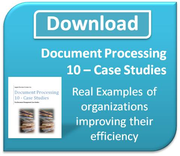Virtually every multifunction printer (MFP) that is sold today has the ability to scan documents. For many purchasers this scanning capability is one of the attractions about doing an upgrade to a new device. They see it as at least the first step to doing some sort of document management and reducing their dependence upon paper files.
The first step in document management.
They are right, it can be a good step but I suggest it is not the first one. Capturing paper documents through scanning is certainly part of the process which can lead to returns. Storing computer generated documents internally is also a great part of the process. Both of these are components to a well designed document management system. They however are NOT the first step.
The real first step: 
"What are you searching for… knowing the end result will save lots of frustrations, and costs on the initial setup--- one time when it’s worth working backwards to get to the start….." This is what a colleague of mine wrote to me the other day. She just refined what the first step in understanding your document processes must be. Know what you want to do with them and figure out how they must be retrieved before you start to build your document management systems. Taking time to understand who, where, and what will be done with the stored documents once they are in a system will make life much easier and lead to a much more successful implementation. Fishing all over for your document when you need to recover it is not something you want to have to do.
Indexing, meta data, file naming convention
These are just some of the terms applied to figuring out how you will access your electronic documents once they are into a system. I like the term indexing as it implies something more than a simple file name which too often is the default of many systems.
Let me explain. An index is just what it says, a listing of the reference information that can be used to find a record. Think of invoices. Do we reference invoices by name or number? Traditionally invoices are created with a numeric, unique reference number. Often this is done by the software used for accounting and producing the invoice. Why? Because is makes it easy for both parties to the transaction to refer to a unique document if they need to discuss it. This is retrieval and applies to both paper and electronic records. Its been used for years and it works.
Many accounting records are handled the same way, purchase orders, service records, inventory reports and the list goes on. Using a simple unique numbering system single documents can be identified out of large quantities of similar files.
The same logic can be applied to other types of work. Correspondence, reports, research files, marketing materials can all be assigned a numerical or alpha numerical code for easy reference. If descriptive titling is required it also can be used to help index files.
How to do it
The essence of successful indexing is to make sure that standards are applied and followed. Enough index information needs to be attached to each record to make it uniquely identifiable and thus retrievable. Think about how hard it would be to find the individual personnel records of all the Smiths or Singhs in a large company if there was no additional information attached to those records.
Building the retrieval system first, by identifying the types of information to store with a document to make it unique is a critical first step to building success into a document management structure. There are tools available to make it easier to do this of course and they are an important part of any design. Do you replicate information like numbers in bar code format for easy capture and processing? Do you link to underlying data bases to pull key information to link to material?
What ever the solutions that are found to work for each implementation the underlying piece of work that must always be considered is how are you going to use the files once they are stored. What is the retrieval requirement(s)? Failure to define it first will make the job so much harder.
Lee K
Photo credit: By Elliott, Joseph, creator [Public domain], via Wikimedia Commons





